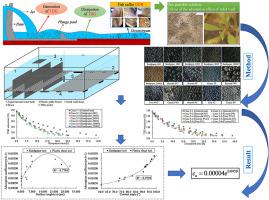Water Research ( IF 11.4 ) Pub Date : 2020-06-28 , DOI: 10.1016/j.watres.2020.116087 Youquan Yuan 1 , Juping Huang 1 , Zhenhua Wang 1 , Yang Gu 1 , Ran Li 1 , Kefeng Li 1 , Jingjie Feng 1

|
Hydropower, which utilizes energy from fast-moving water, can help alleviate the energy crisis and promote economic development. For safety and ecological purposes, dams must discharge periodically. This discharge process, which occurs with the supersaturation of total dissolved gas (TDG), affects the fish and other aquatic organisms living in downstream river areas. Previous studies have shown that the supersaturated TDG dissipation process is closely related to hydraulic properties such as the flow rate, water depth and turbulent kinetic energy. Additionally, the presence of solid walls such as vegetation leaves in water can adsorb dissolved gases in water, thereby promoting the supersaturated TDG dissipation process, and the adsorption effect is closely related to the solid wall material. However, systematic studies on how solid walls in water can quickly absorb dissolved gases from water and rapidly reduce the TDG saturation of water are lacking. Herein, a series of experiments was conducted to study the dissipation process of supersaturated TDG under the action of solid walls in water and to reveal the adsorption effect of solid wall surface properties on dissolved gas. The results showed that the surface roughness and hydrophobicity (contact angle) are the key factors related to the adsorption effect of solid walls on the TDG in water. Generally, the dissipation rate of supersaturated TDG first increased and then decreased with increasing surface roughness. The supersaturated TDG dissipation rate increased monotonically with increasing contact angle. Based on the experimental data, the adsorption coefficient, which represents the adsorption effect of the solid wall for dissolved gas in water, was proposed, and a prediction formula between the adsorption coefficient and the contact angle of the solid wall was established. These results can provide theoretical support for the utilization of the solid wall adsorption effect to mitigate the adverse effects of supersaturated TDG and protect fish.
中文翻译:

过饱和总溶解气体耗散过程的实验研究:关注固体壁的吸附效果。
利用快速流动的水产生的能量的水力发电可以帮助缓解能源危机并促进经济发展。为了安全和生态目的,水坝必须定期排放。随着总溶解气体(TDG)的过饱和而发生的这种排放过程会影响下游河流地区的鱼类和其他水生生物。先前的研究表明,过饱和的TDG耗散过程与水力特性(例如流量,水深和湍动能)密切相关。另外,水中诸如植物叶片的固体壁的存在可以吸收水中的溶解气体,从而促进过饱和的TDG耗散过程,并且吸附效果与固体壁材料密切相关。然而,缺乏关于水中固体壁如何快速吸收水中溶解气体并快速降低水的TDG饱和度的系统研究。在此,进行了一系列实验以研究过饱和TDG在水中固体壁作用下的耗散过程,并揭示了固体壁表面性质对溶解气体的吸附作用。结果表明,表面粗糙度和疏水性(接触角)是影响固体壁在水中对TDG的吸附作用的关键因素。通常,随着表面粗糙度的增加,过饱和TDG的耗散率先增加然后降低。TDG的过饱和耗散率随着接触角的增加而单调增加。根据实验数据,吸附系数 提出了代表固体壁对水中溶解气体的吸附效果的方法,建立了固体壁的吸附系数与接触角的预测公式。这些结果可为利用固体壁吸附效应减轻过饱和TDG的不利影响和保护鱼类提供理论支持。











































 京公网安备 11010802027423号
京公网安备 11010802027423号